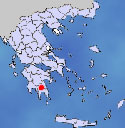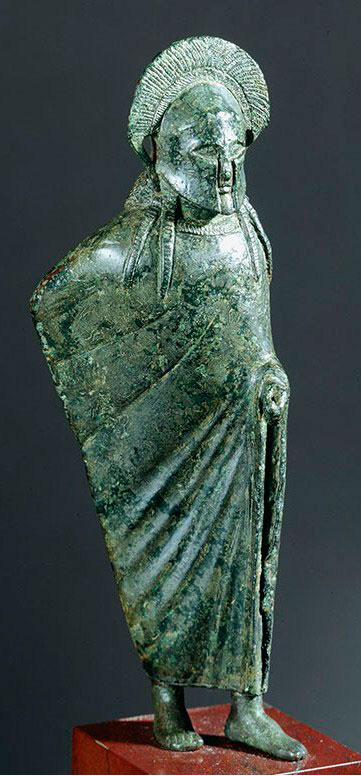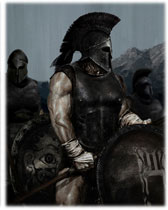Military Resource

Warfare,
Warriors & Empires.
| Ancient Military | |||
|
Ancient
Empires
|
|||
 |
|||
Sparta A polis, or Greek state, located in Peloponnesia |
|||
 |
|||
Spartan
Hoplite A Statue of a hoplite warrior from Sparta. All Spartan males were warriors and aristocracy. |
|||
The Spartan Military |
 |
 |
||
| The Spartan
City State (Sparta) produced what is probably the most iconic military
in ancient history. The ancient Spartan warriors are known for their
bravery, professionalism and skill, a reputation well deserved. At
their zenith they proved themselves to be the best of the Greek hoplite
warriors, the premier fighting force of their time. Spartan political
power peaked from the 6th to 4th century BC; however Spartan military
power had its roots much earlier. . The evolution of the Spartan army began during the heroic Mycenaean age (1600 BCE to 1100 BCE), a time in Greek history when tactics were simple and warriors sought individual glory (and fought out of formation). Invading warlike Indo-Europeans attacked from the North in one part of histories most massive invasions, spanning the ancient near east from Egypt to India. Waves of invaders vied for land with the local populations. |
||||
The Spartan Military Spartan soldiers were the ultimate hoplite warriors, devoting their lives to training as heavy infantry. |
|
|||
Ancient Spartan Miliary OriginsDark Times in Ancient Greece In Peloponnesia excavations at Pylos
and Nichoria have revealed for Messenia's late Bronze Age (1300s
BC) a bureaucratic, agricultural kingdom ruled by the wanax at Pylos.
The Messenians spoke Mycenaean Greek, and worshipped the Greek gods
at local shrines. Later, Greeks believed a body of Dorians under
Cresphontes invaded the country from the Northern Greece or Macedonia,
establishing control over Peloponnesia. However, given that the
Arcadian language is a direct and conservative descendent of Mycenaean
Greek, it is more likely that the Dorians pushed the native Messenians
into Arcadia if the invasion happened at all. The Dorians then merged
with the previous inhabitants producing an the Messenian and Spartan
tribes, groups that developed a strong national feeling. However,
the relative wealth of Messenia in fertile soil and favourable climate
attracted the expansionistic neighbouring Spartans. War broke out,
it was said, as a result of the murder of the Spartan king Teleclus
by the Messenians - which, in spite of the heroism of King Euphaes
and his successor Aristodemus ended in the subjection of Messenia
to Sparta (c. 720 BC). The numericaly inferior Spartans, realizing
that they probably wouldn’t be as lucky the next time they
fought the Messenians decided on a very rare course of action in
the Greek world and set out to obtain complete military and social
supremacy over their defeated neighbors. Two generations later the
Messenians revolted and under the leadership of Aristomenes kept
the Spartans at bay for some seventeen years (648 BC—631 BC).
However, the stronghold of Ira (Eira) fell after a siege of eleven
years and the Messenians where placed back under the heal of Sparta. The Spartan poet Tyrtaeus describes
how the Messenians endured the insolence of the masters: During the 7th century Lelantine War, a long war between the Greek trading powers Eretria and Chalcis and their allies, distracted the Greeks, Sparta made a power grab. The Spartans vowed to conquer their neighbors, Messenia, no matter how long and how many set backs they suffered. Messenia, a group of eight polis that had never quite united, had rich soil and that attracted the Spartans. The Spartan attack came as a surprise; however it took two more decades to win the war. The numericaly inferior Spartans, realizing that they probably wouldn’t be as lucky the next time they fought the Messenians decided on a very rare course of action in the Greek world and set out to obtain complete military and social supremacy over their defeated neighbors.Two generations later the Messenians revolted, it took the Spartans took 17 years to bring them back under control, including an eleven year siege on the stronghold of Ira. The next revolt didn’t breakout until 464 BC, but fear of Messenian uprisings would linger in the Spartans national memory for the rest of its existence. The Spartans called those who hadn’t fled helots and forced them into grueling servitude. However, the Spartans realizing that they were outnumbered four to one, and that the Helots would kill them at the first chance they got, fearful of the Messenians uprising the Spartans created a unique society among the Greeks. They used the helots as laborers and farmers to free the Spartan men for professional military service. Spartan life then became more militarized then any other city state, while the other Greeks became citizen/farmers and warriors the Spartan men all became professional warriors. In fact it was the only job available to a Spartan man. This freed them to launch military champions during any season while the other Greeks had to tend to their fields. The society of the Spartans was considered strange to the other Greeks. They became obsessed with military power, focusing on exercise, discipline and their ability to endure any hardship. Around Greece they gained, and promoted, this reputation as a tough, unyielding and hardened society. When some diplomats visited from Athens they were given a black gruel for their meal, although this wasn’t standard Spartan fair, the Athenians returned home with tales about the Spartan’s disgusting food and obsession with warfare. After their subjugation of Messenia the Spartans went to war against Argos, where they were taught a lesson. A Spartan army was defeated by a phalanx; this formation of spearmen was a major advancement over the free for all tactics previously used. The Greek world took notice and soon the new middle class formed a warrior class based on phalanx heavy infantry tactics. These hoplites (named after their large shields or hoplons) became both a major political and military force throughout Greece. They employed basically the same tactics as the Argos but Spartan weapons were tweaked for efficiency in close order combat. In a phalanx formation hoplites formed shieldwalls by overlapping their large shields, the left of each shield protecting the warrior to the left. Only the shins and head of the hoplite wear exposed, and these were well protected by grieves and helmets. The spears of the first three ranks of a phalanx formation could be used offensively. Although the phalanx was not a Spartan innovation they became the best hoplites in Greece through constant drilling. Individual Spartan warriors were highly disciplined and frequently exercised to increase their stamina, an important attribute when phalanxes clashed. (For more details on phalanx formations and tactics see Ancient Weapons: Spears or Greek Warriors - Hoplites and Phalanxes section). Spartan Military Culture The Spartan armies dominated Greece after their victory in the exhausting Peloponnesian Wars (460 to 404 BC). Both their individual warriors and group tactics where honed to a perfection never before seen on the battlefield. The lifestyle of these ancient warriors has even become a word in the English language meaning sternly disciplined and rigorously simple, frugal, or austere. Spartan also means brave and undaunted. Spartan Warriors: Birth and
Training The training of Spartan warriors
started when they were boys. They were sent to a military boarding
school, or agoge, at age seven where they formed a class with other
boys their age. Their education emphasized physical, mental and
spiritual toughness and could be quite brutal. They where taught
to endure hardship and pitted against each other in fights by their
instructors. Adolescents were used to terrorize the Helots, and
in a particularly nasty tradition called a Krypteia they were sent
out at night with the goal of killing any helot precieved to be
a threat or unlucky enough to be discovered out alone. Each fall
the Spartans would declare war on the Helot making it legal to kill
any Helot. Sparta was known for being the only Greek city without a city wall, a famous saying among Spartans went something like, “Our men are our walls.” Spartan Armor Spartan Weapons Spartan warriors also carried a short
sword, the xiphos, to be used as a secondary weapon and in the crush
of battle when only a short weapon could be used effectively. The
blade of a xiphos was typically about 2 feet (50-60 cm) long. The
blade was shaped like a long leaf and could be used for slashing;
however they were usually used for stabbing. The Spartans used an
even shorter xiphos than the other Greeks, the blade measuring only
1-1½ feet (30-40cm) long making it even easier to use in
tight places. The xiphos could be used to stab at the unprotected
groin, armpit or throat of an enemy. The Spartans had lost up to
4000 hoplites and the helots revolted, a one two punch they would
never recover from as Spartan citizenship was dependant on blood
lines and their was no way to quickly regain manpower in their rigid
society. The Spartan military had entered its long slow decline, eventualy their once cutting edge ancient weapons and tactics were even eclipsed.
Nonetheless, Sparta was able to continue as a regional power for
another two centuries. Neither Philip II nor his son Alexander the
Great attempted to conquer Sparta itself respecting Spartan martial
skill and not wanting to risk potentially high losses. It was reported
that as late as 378 AD, following the disastrous defeat of the Roman
imperial army at the Battle of Adrianople that a Spartan militia
organized a phalanx and defeated a force of raiding Goths in battle. |
||||